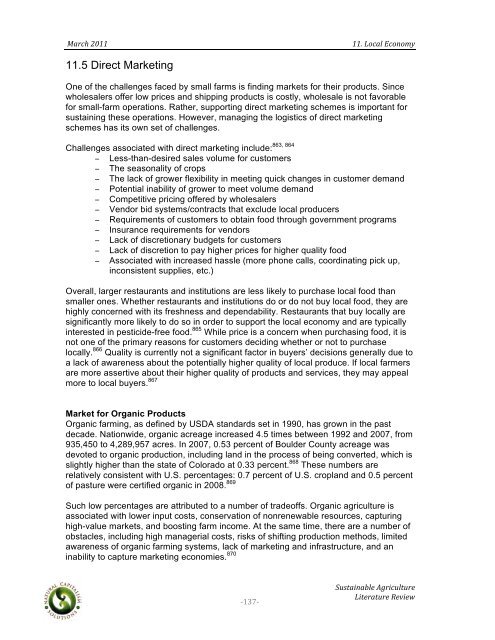Sustainable Agriculture Literature Review - Boulder County
Sustainable Agriculture Literature Review - Boulder County
Sustainable Agriculture Literature Review - Boulder County
You also want an ePaper? Increase the reach of your titles
YUMPU automatically turns print PDFs into web optimized ePapers that Google loves.
! !!<br />
"#$%&!'())!! !!!!!!!!!!!!!!!!!!!!!!!!!!!!!!!!!!!!!!!!!!!!!!!!!!!!!!!!!!!!!!))+!9-%#/!H%-5-BF!<br />
11.5 Direct Marketing<br />
One of the challenges faced by small farms is finding markets for their products. Since<br />
wholesalers offer low prices and shipping products is costly, wholesale is not favorable<br />
for small-farm operations. Rather, supporting direct marketing schemes is important for<br />
sustaining these operations. However, managing the logistics of direct marketing<br />
schemes has its own set of challenges.<br />
863, 864<br />
Challenges associated with direct marketing include:<br />
! Less-than-desired sales volume for customers<br />
! The seasonality of crops<br />
! The lack of grower flexibility in meeting quick changes in customer demand<br />
! Potential inability of grower to meet volume demand<br />
! Competitive pricing offered by wholesalers<br />
! Vendor bid systems/contracts that exclude local producers<br />
! Requirements of customers to obtain food through government programs<br />
! Insurance requirements for vendors<br />
! Lack of discretionary budgets for customers<br />
! Lack of discretion to pay higher prices for higher quality food<br />
! Associated with increased hassle (more phone calls, coordinating pick up,<br />
inconsistent supplies, etc.)<br />
Overall, larger restaurants and institutions are less likely to purchase local food than<br />
smaller ones. Whether restaurants and institutions do or do not buy local food, they are<br />
highly concerned with its freshness and dependability. Restaurants that buy locally are<br />
significantly more likely to do so in order to support the local economy and are typically<br />
interested in pesticide-free food. 865 While price is a concern when purchasing food, it is<br />
not one of the primary reasons for customers deciding whether or not to purchase<br />
locally. 866 Quality is currently not a significant factor in buyers’ decisions generally due to<br />
a lack of awareness about the potentially higher quality of local produce. If local farmers<br />
are more assertive about their higher quality of products and services, they may appeal<br />
more to local buyers. 867<br />
Market for Organic Products<br />
Organic farming, as defined by USDA standards set in 1990, has grown in the past<br />
decade. Nationwide, organic acreage increased 4.5 times between 1992 and 2007, from<br />
935,450 to 4,289,957 acres. In 2007, 0.53 percent of <strong>Boulder</strong> <strong>County</strong> acreage was<br />
devoted to organic production, including land in the process of being converted, which is<br />
slightly higher than the state of Colorado at 0.33 percent. 868 These numbers are<br />
relatively consistent with U.S. percentages: 0.7 percent of U.S. cropland and 0.5 percent<br />
of pasture were certified organic in 2008. 869<br />
Such low percentages are attributed to a number of tradeoffs. Organic agriculture is<br />
associated with lower input costs, conservation of nonrenewable resources, capturing<br />
high-value markets, and boosting farm income. At the same time, there are a number of<br />
obstacles, including high managerial costs, risks of shifting production methods, limited<br />
awareness of organic farming systems, lack of marketing and infrastructure, and an<br />
inability to capture marketing economies. 870<br />
!<br />
"')+"<br />
!,342#.5#6/1!78$.%3/23$1!<br />
9.21$#23$1!:1;.1
















